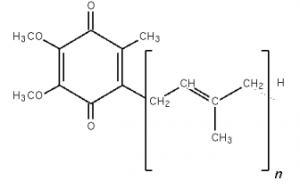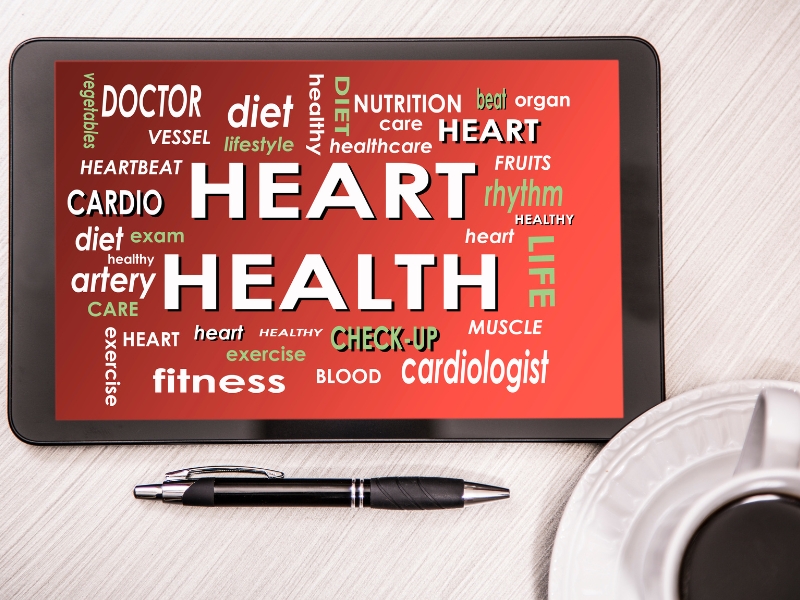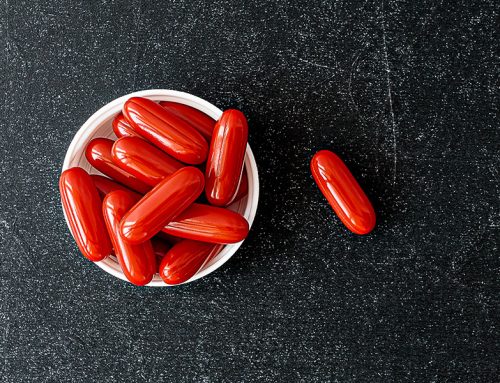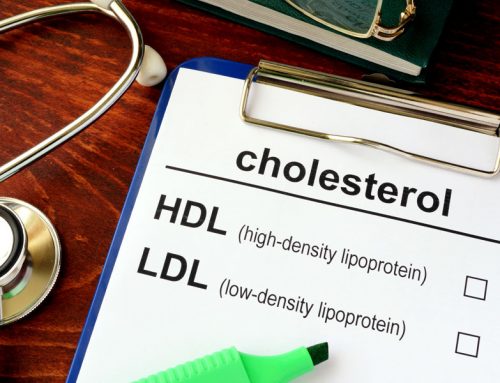
Coenzyme Q10, also known as ubiquinone, is a fat-soluble substance that is similar to a vitamin but is synthesized in our bodies. In adulthood, the body’s synthesis of Coenzyme Q10 declines with increasing age. Furthermore, statin medications inhibit the body’s production of Coenzyme Q10. Supplementation is nearly always necessary; it is not possible to make up deficits of Coenzyme Q10 by careful eating. Optimal concentrations of Coenzyme Q10 in the blood and in the heart muscle tissues is especially important for good heart health.
Coenzyme Q10 has become the third most purchased specialty nutritional supplement according to a recent survey. The number of daily users of Coenzyme Q10 in the United States has risen from some 3 million people in the year 2000 to over 16 million people at present [Sinatra 2018].
There are good reasons for this increase, which the American cardiologist Dr. Stephen Sinatra has explained in a recent electronic book published by the WholeFoods Magazine [Sinatra 2018]. I want to summarize Dr. Sinatra’s reasoning for my readers.
Why Coenzyme Q10 supplements for heart health?
Dr. Sinatra begins by relating Coenzyme Q10 supplementation to good heart health:
- Human heart disease is significantly associated with low concentrations of Coenzyme Q10 in the blood and in heart muscle tissue [Folkers 1985].
- Once we humans reach adulthood, our bodies synthesize less and less Coenzyme Q10 with increasing age [Kalén 1989]. Dr. Sinatra asserts that it is practically impossible for us to get an optimal intake of Coenzyme Q10 from food alone. We simply cannot eat as many Coenzyme Q10-rich foods as would be needed to achieve the heart health protection that comes from a well-formulated Coenzyme Q10 supplement.
- Coenzyme Q10 is an essential co-factor in the cellular production of ATP energy molecules [Sinatra 2018]. Low levels of Coenzyme Q10 in the heart muscle cells leads inevitably to an energy-starved heart [Mortensen]. This is very important: the heart never rests; consequently, it needs ATP energy molecules constantly.
- Coenzyme Q10 in its reduced form is, moreover, a fat-soluble antioxidant that protects the heart muscle cells against oxidative damage [Sinatra 2018].
Note: Oxidative damage is the damage caused to proteins, lipids, and DNA by harmful reactive oxygen species. Oxidative damage is associated with the development of atherosclerosis, heart failure, and heart attack [Münzel].
Adequate Coenzyme Q10 concentrations in the blood prevents the oxidation of the LDL (= bad cholesterol) [Sinatra 2018].
Coenzyme Q10 and heart disease clinical studies
In his e-book, Dr. Sinatra summarizes the results of the some of the important clinical studies of Coenzyme Q10 supplementation and heart health. Dr. Sinatra points first to the results of the two-year Q-Symbio study in which 420 patients with moderate to severe heart failure were randomly assigned to take Coenzyme Q10 (100 milligram capsules three times daily, with meals) or to take matching placebos in addition to their conventional heart medications.
Coenzyme Q10: an adjuvant treatment for heart failure
The results of the Q-Symbio study were published in the Heart Failure specialty journal of the Journal of the American College of Cardiology [Mortensen 2014]:
- Significant reduction of major adverse cardiovascular events
- Significant reduction in overall mortality
- Significant reduction in heart disease mortality
- Significant reductions in heart failure hospitalizations
Meta-analysis: Coenzyme Q10 and improved ejection fraction
Next, Dr. Sinatra reviews the meta-analysis of 13 clinical studies published by Dr. Domnica Fotino, assistant professor of medicine, Tulane University. Dr. Fotino’s study reported evidence of significantly improved ejection fraction in patients receiving Coenzyme Q10 supplements as compared to control patients [Fotino 2013]. Dr. Sinatra attributes the positive effects to Coenzyme Q10’s role in the synthesis of ATP energy molecules in the heart muscle [Sinatra 2018].
Note: Ejection fraction is a measurement used by cardiologists to determine what percentage of the total amount of blood in the left ventricle the heart is pumping out with each contraction. For example, an EF of 60% would mean that the heart is pushing out 60% of the total amount of blood in the left ventricle. A normal EF is between 50% and 70%. Lower percentages are indicative of heart failure. [American Heart Association].
Catch-22: Statins medications and lower Coenzyme Q10 as well as lower cholesterol
Thirdly, Dr. Sinatra addresses the issue of cholesterol lowering statin medications and Coenzyme Q10. A 2004 study showed that 80 milligrams of atorvastatin calcium daily significantly reduced Coenzyme Q10 blood concentrations after 14 days of treatment, thereby increasing the patients’ risk of heart failure and stroke [Rundek 2004].
Dr. Sinatra puts his finger on the Catch-22 in treatment with statin medication: Statins do reduce high cholesterol levels, but, in so doing, the statin medications also reduce Coenzyme Q10 concentrations and deprive the heart muscle cells of the co-factor they need to generate ATP energy molecules [Sinatra 2018].
Coenzyme Q10 together with statin medications
Because statin therapy depletes Coenzyme Q10 concentrations, Dr. Sinatra recommends that anyone who is taking a statin medication talk to his or her cardiologist about Coenzyme Q10 supplementation [Sinatra 2018].
Restrictions on the use of Coenzyme Q10 supplements?
Dr. Sinatra notes that Coenzyme Q10 supplements are safe and well-tolerated with only rare and minimal side effects reported, for example, abdominal discomfort [Sinatra 2018]. There have been no reports of significant side effects at daily dosages as high as 1200 milligrams for up to 16 months [Sinatra 2018].
Typical daily doses are 100 – 300 milligrams per day. Dr. Sinatra says that doses above 100 milligrams per day are generally divided up into two or three doses during the day and are always taken with meals. Dividing the doses improves absorption and reduces whatever discomfort there might otherwise be.
Coenzyme Q10 supplements have not been tested in pregnant and breast-feeding women, so, for that reason alone, pregnant women and new mothers should avoid Coenzyme Q10 supplementation unless ordered by a physician [Sinatra 2018].
Summary: who needs a daily Coenzyme Q10 supplement?
- Healthy individuals aged 40 and above
- Heart failure patients
- Patients taking a statin medication
- Individuals in stressful life or work situations
- Individuals with demanding exercise programs
- Individuals with nutritionally poor diets
Dr. Sinatra’s publications
Dr. Sinatra, a board-certified cardiologist and a fellow of the American College of Cardiology, has drawn on his many years of clinical experience to write the following books:
- The Sinatra Solution: Metabolic Cardiology, 2015
- Nutritional and Integrative Strategies in Cardiovascular Medicine, 2015
- The Great Cholesterol Myth: Why Lowering Your Cholesterol Won’t Prevent Heart Disease-and the Statin-Free Plan That Will, 2012
- Coenzyme Q10 and the Heart, 1999
- The Coenzyme Q10 Phenomenon, 1998
Read our key article about CoQ10 and cardiovascular health in elderly people
Read our key article on CoQ10 as adjuvant therapy for heart failure
Sources
American Heart Association. (2018). Ejection Fraction Heart Failure Measurement. Retrieved from http://www.heart.org/HEARTORG/Conditions/HeartFailure/DiagnosingHeartFailure/Ejection-Fraction-Heart-Failure-Measurement_UCM_306339_Article.jsp
Folkers, K., Vadhanavikit, S., & Mortensen, S. A. (1985). Biochemical rationale and myocardial tissue data on the effective therapy of cardiomyopathy with coenzyme Q10. Proceedings of The National Academy of Sciences of The United States of America, 82(3), 901-904.
Fotino, A. D., Thompson-Paul, A. M., & Bazzano, L. A. (2013). Effect of coenzyme Q₁₀ supplementation on heart failure: a meta-analysis. The American Journal Of Clinical Nutrition, 97(2), 268-275. doi:10.3945/ajcn.112.040741
Kalén, A., Appelkvist, E. L., & Dallner, G. (1989). Age-related changes in the lipid compositions of rat and human tissues. Lipids, 24(7), 579-584.
Mortensen, S. A., Rosenfeldt, F., Kumar, A., Dolliner, P., Filipiak, K. J., Pella, D., & … Littarru, G. P. (2014). The effect of coenzyme Q10 on morbidity and mortality in chronic heart failure: results from Q-SYMBIO: a randomized double-blind trial. JACC. Heart Failure, 2(6), 641-649. doi:10.1016/j.jchf.2014.06.008
Münzel, T., Camici, G.G., Maack, C., Bonetti, N.R., Fuster, V. & Kovacic, J.C. (2017). Impact of Oxidative Stress on the Heart and Vasculature. J Am Coll Cardiol., 11;70(2):212-229. doi: 10.1016/j.jacc.2017.05.035
Rundek, T., Naini, A., Sacco, R., Coates, K., & DiMauro, S. (2004). Atorvastatin decreases the coenzyme Q10 level in the blood of patients at risk for cardiovascular disease and stroke. Arch Neurol., 61(6):889-92.
Sinatra, S. (2018). The CoQ10 Connection: The Secret Nutrient for Optimal Health. WholeFoods Magazine. Retrieved from http://bt.e-ditionsbyfry.com/publication/?i=473278#%22{"issue_id":473278,"page":0}%22
Disclaimer: The information contained in this review article is not intended as medical advice and should not be construed as such.









Leave A Comment